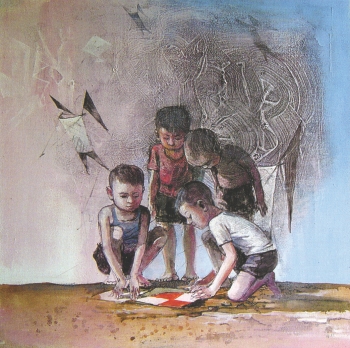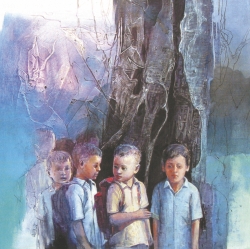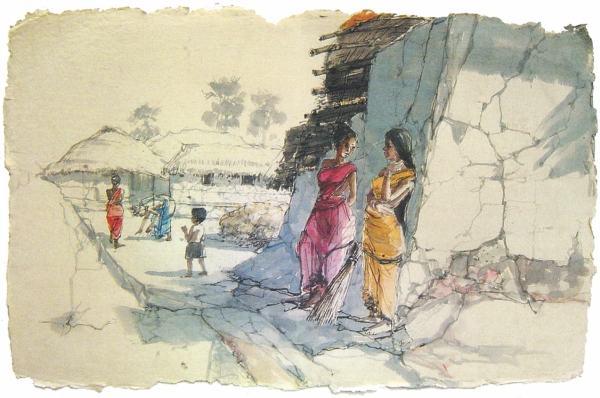| Home - Back Issues - The Team - Contact Us |
 |
| Volume 10 |Issue 37 | September 30, 2011 | |
|
|
Art Painting Life's Portrait Fayza Haq
Sheikh Afzal, who is reputed for being one of the finest of portrait painters of the country, places his soul pitch before willing clients. He says, “The time taken for an illustration for a national cause – in magazines and dailies– will take up as much time as a portrait for which one can earn forty thousand taka instead. For an illustration in pen and ink plus wash, one can't hope for more than a mere one thousand taka, at the most. Yet, one enjoys working for a cause, and it gives mental satisfaction.” Sheikh Afzal says that in countries like Bahrain, and some of the other parts of the Middle East, figurative work is a part of life. In Iran, some years, before Ayatullah Khoumini and others led the thinking people of Iran– the “Rubbayat of Omar Khayyam” and Kahlil Gibran were a part of life. Horses, elephants, hunting dogs, along with delicate damsels and galloping princes on chargers were found in Mughal, Turkish and conventional Iranian art – with the horse “Duldul”, dear to the hearts of Shiite world and in the Indian Subcontinent too. Other portrait painters are there too, in Bangladesh, like Jamal Ahmed, Ranjit Das, and Kuhu, who excel in figurative work as well. The Department of Fine Arts, DU has nurtured many famous figurative painters such as S M Sultan, Zainul Abedin, Quamrul Hasan, Aminul Islam and Safiuddin Ahmed. Of course, often, they combined man seen against nature – as does also Sheikh Afzal. This artist, trained in Japan in higher studies, after having done the basics in Bangladesh, had teachers and guides like Rafiqun Nabi. The portrait painter mastered the paints with experts in the Far East. Sheikh Afzal says that it was his father who encouraged him at the outset. The artist recalls a speech given by Bangabandhu in Sheikh Afzal's home town in Kushtia. He was about ten, at that time, and his elders made way for him, as he sketched the leader to his heart's content. Sheikh Mujib rewarded him with Tk 20, and promised him a place at the Dhaka Art College as the Department of fine Arts was known back then, saying that Zainul Abedin was a close friend of his. Alas, the charismatic leader was assassinated before Sheikh Afzal was old enough to enter the Art College at Dhaka.
Asked if it were easy for an artist, who does figurative work in a Muslim country Sheikh Afzal says: “In museums, at offices like the 'Bangabhaban' etc. they need portraits like that of Bangabundhu, which I provide happily, with ease. I create the texture on the canvas, and then create more, blending the backdrop with the main figure, in the front. In many of my works one sees man set against a backdrop of gorgeous representation of hills, trees, skies, boulders and rivulets. This is a mirror of life. Even without the backdrop I provide the character and feelings of my subject with the colours that I select to put in. I try to use monochrome colours. If I'm worried about what the onlooker feels about depiction of live forms, I'll not go far. I've to take a stand of my own. There are some restrictions in Muslim countries, but I'm not overly concerned about that. In countries like Bahrain, Dubai or Tunisia there is figurative work going hand in hand with abstraction and calligraphy. There is sculpture in these countries too. Each one to his taste. Art collectors remain eager patrons.” The artist says that it is his father who encouraged him to go into the art world. He says that his parents were extremely fond of music, and his father himself dabbled in drawing and painting. Dwelling on his teachers at the Art College, he says they were painters like Rafiqun Nabi, Abul Baset, Shahid Kabir and Mahmudul Haque, who themselves are realistic painters. “My professor in Japan, Yamamoto Fumihiko also encouraged me to go into realism,”says Sheikh Afzal. Touching on the deaths of Mohammed Kibria and Aminul Islam, also with the death of Maqbool Fida Husain—all taking place around the same time, he says, “Kibria sir and Aminul Islam sir went to Europe in the sixties. They introduced abstraction and semi abstraction to the young painters in Bangladesh. When they left us for the pearly gates, we naturally felt a dreadful vacuum. They were so warm and affectionate, taking the young painters under their wing, that we will always feel the loss of these master painters. Their work will always be there in our minds and hearts. The passing away of Maqbul Fida Husain was also a tremendous loss to the art world. It's a pity that he had to live and die outside his home country. Speaking about art in Lahore, Pakistan, which he visited in the recent past, the artist says that in our country there is a lot of variations. The standard of art in Bangladesh is fairly good, he believes with conviction. Is our country lagging behind its neighbour, India, as India is a vast country, in comparison, and naturally has many more painters and patrons, as well as galleries, to encourage painters? Sheikh Afzal says, “We are not behind anyone in the subcontinent. However, there is so much of competition in India, there being many more artists, the Indian artists have to work, in comparison. We, in Bangladesh, have more scope to excel, as ours is a smaller country. For us, the competition is not that overwhelming.”
Copyright (R) thedailystar.net 2011 |
||||


